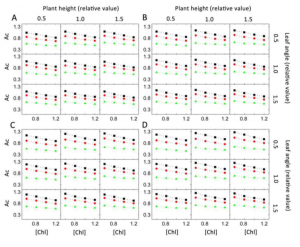DOI: 10.1111/pce.13041
The impact of modifying photosystem antenna size on canopy photosynthetic efficiency
Abstract
 Canopy photosynthesis (Ac) describes photosynthesis of an entire crop field and the daily and seasonal integrals of Ac positively correlate with daily and seasonal biomass production. Much effort in crop breeding has focused on improving canopy architecture and hence light distribution inside the canopy. Here, we develop a new integrated canopy photosynthesis model including canopy architecture, a ray tracing algorithm and C3 photosynthetic metabolism to explore the option of manipulating leaf chlorophyll concentration ([Chl]) for greater Ac and nitrogen use efficiency (NUE). Model simulation results show that (1) efficiency of photosystem II increased when [Chl] was decreased by decreasing antenna size and (2) the light received by leaves at the bottom layers increased when [Chl] throughout the canopy was decreased. Furthermore, the modeling revealed a modest ~3% increase in Ac and an ~14% in NUE was accompanied when [Chl] reduced by 60%. However, if the leaf nitrogen conserved by this decrease in leaf [Chl] were to be optimally allocated to other components of photosynthesis, both Ac and NUE can be increased by over 30%. Optimizing [Chl] coupled with strategic reinvestment of conserved nitrogen is shown to have the potential to support substantial increases in Ac, biomass production and crop yields.
Canopy photosynthesis (Ac) describes photosynthesis of an entire crop field and the daily and seasonal integrals of Ac positively correlate with daily and seasonal biomass production. Much effort in crop breeding has focused on improving canopy architecture and hence light distribution inside the canopy. Here, we develop a new integrated canopy photosynthesis model including canopy architecture, a ray tracing algorithm and C3 photosynthetic metabolism to explore the option of manipulating leaf chlorophyll concentration ([Chl]) for greater Ac and nitrogen use efficiency (NUE). Model simulation results show that (1) efficiency of photosystem II increased when [Chl] was decreased by decreasing antenna size and (2) the light received by leaves at the bottom layers increased when [Chl] throughout the canopy was decreased. Furthermore, the modeling revealed a modest ~3% increase in Ac and an ~14% in NUE was accompanied when [Chl] reduced by 60%. However, if the leaf nitrogen conserved by this decrease in leaf [Chl] were to be optimally allocated to other components of photosynthesis, both Ac and NUE can be increased by over 30%. Optimizing [Chl] coupled with strategic reinvestment of conserved nitrogen is shown to have the potential to support substantial increases in Ac, biomass production and crop yields.